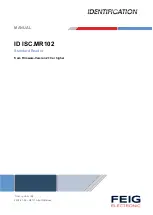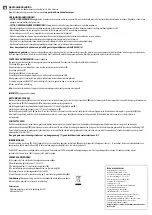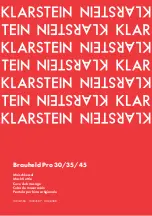
As can be seen, there are two separate parameters in the IED for selecting port numbers
for TCP connections; one for IEEE1344 protocol (
1344TCPport
) and another one for
C37.118 protocol (
C37.118 TCPport
). Client can communicate with the IED over
IEEE1344 protocol using the selected TCP port defined in
1344TCPport
, and can
communicate with the IED over IEEE C37.118 protocol using the selected TCP port
number in
C37.118TCPport
.
All the frames (the header frame, configuration frame, command frame and data frame)
are communicated over the same TCP port. The client can request (by sending a
command frame) a configuration and/or header via the TCP channel and the requested
configuration and/or header will be sent back to the client (as Configuration frame/
Header frame) over the same TCP channel.
Once the TCP client connects to the IED, the client has to necessarily send a command
frame to start a communication. As shown in Figure
, the IED can support 2
PMUREPORT instances and the client has to specify the PMU ID Code in order to
know which PMUREPORT data needs to be sent out to that client. In this figure, X and
Y are referring to the user-defined PMU ID Codes for PMUREPORT instances 1 or 2,
respectively. It is up to the TCP client to decide which PMUREPORT function block
shall communicate with that client. Upon successful reception of the first command by
the IED, the PMU ID will be extracted out of the command; if there is a PMUREPORT
instance configured in the IED with matching PMU ID, then the client connection over
TCP with the IED will be established and further communication will take place.
Otherwise, the connection will be terminated and the
TCPCtrlCfgErrCnt
is
incremented in the PMU Diagnostics on the Local HMI under
Main menu/
Diagnostics/Communication/PMU diagnostics/PMUSTATUS:1
It is possible to turn off/on the TCP data communication by sending a IEEE1344 or
C37.118 command frame remotely from the client to the PMU containing
RTDOFF/
RTDON
command.
At any given point of time maximum of 8 TCP clients can be connected to the IED for
IEEE1344/C37.118 protocol. If there is an attempt made by the 9th client, the
connection to the new client will be terminated without influencing the connection of
the other clients already connected. A list of active clients can be seen on the Local
HMI in the diagnostics menu under
Main menu/Diagnostics/Communication/PMU
diagnostics/PMUSTATUS:1
6.1.3.2
Short guidance for use of UDP
GUID-F5BCBBF7-4EED-4E79-9E86-AF046D201BB1 v3
The IED supports maximum of 6 concurrent UDP streams. They can be individually
configured to send IEEE1344 or C37.118 data frames as unicast / multicast. Note that
[x] at the end of each parameter is referring to the UDP stream number (UDP client
group) and is a number between 1 and 6. Each of the 6 UDP groups in the IED has the
following settings:
1MRK 511 401-UUS A
Section 6
Wide area measurement system
Bay control REC670 2.2 ANSI
103
Application manual
Summary of Contents for Relion REC670
Page 1: ...RELION 670 SERIES Bay control REC670 Version 2 2 ANSI Application manual ...
Page 2: ......
Page 26: ...20 ...
Page 42: ...36 ...
Page 96: ...90 ...
Page 274: ...268 ...
Page 292: ...286 ...
Page 298: ...292 ...
Page 308: ...302 ...
Page 470: ...464 ...
Page 514: ...508 ...
Page 608: ...602 ...
Page 646: ...640 ...
Page 656: ...650 ...
Page 657: ...651 ...
















































